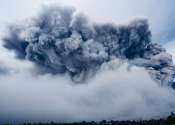Undersea volcanism may explain medieval year of darkness
Starting in 536 A.D., the sky went dark for more than a year. In some parts of Europe and Asia, the sun only shone for about four hours a day, and "accounts say the sun gave no more light than the moon," says Dallas Abbott, ...









